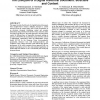Free Online Productivity Tools
i2Speak
i2Symbol
i2OCR
iTex2Img
iWeb2Print
iWeb2Shot
i2Type
iPdf2Split
iPdf2Merge
i2Bopomofo
i2Arabic
i2Style
i2Image
i2PDF
iLatex2Rtf
Sci2ools
DOCENG
2004
ACM
2004
ACM
The lifecycle of a digital historical document: structure and content
This paper describes the lifecycle of a digital historical document, from template-based structure definition through to content extraction from the scanned pages and its final reconstitution as an electronic document (combining content and semantic information) along with the tools that have been created to realise each stage in the lifecycle. The whole approach is described in the context of different types of typewritten documents relating to prisoners in World-War II concentration camps and is the result of a multinational collaboration under the MEMORIAL project
Digital Historical Document | DOCENG 2004 | II Concentration Camps | Template-based Structure Definition |
| Added | 30 Jun 2010 |
| Updated | 30 Jun 2010 |
| Type | Conference |
| Year | 2004 |
| Where | DOCENG |
| Authors | Apostolos Antonacopoulos, Dimosthenis Karatzas, Henryk Krawczyk, Bogdan Wiszniewski |
Comments (0)

